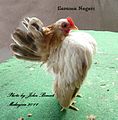| Revision as of 14:12, 10 May 2012 edit204.11.133.214 (talk) →Gallery← Previous edit | Revision as of 14:17, 10 May 2012 edit undoChipmunkdavis (talk | contribs)Autopatrolled, Extended confirmed users, Pending changes reviewers, Rollbackers66,796 edits Rmv information not backed up by source, adding information the source actually supportsNext edit → | ||
| Line 3: | Line 3: | ||
| ==History== | ==History== | ||
| Serema originate in the Malaysian state of ], apparently through the crossing of Japanese and Malaysian bantams.<ref name="Feathersite">{{cite web|url=http://www.feathersite.com/Poultry/CGP/Sri/BRKSri.html |title=Serama |publisher=Feathersite |accessdate=10 May 2012}}</ref> Other stories of the birds derived from a gift of some small chickens by the King of Thailand to a local sultan in ancient times. Small chickens have always been popular pets in this area and are often referred to as "ayam katik" (pygmy chickens) and "ayam cantik" (pretty chickens). | |||
| The modern breed is attributed to the efforts of Wee Yean Een from Kelantan, who named the breed "Serama" after |
The modern breed is attributed to the efforts of Wee Yean Een from Kelantan, who named the breed "Serama" after Rama, the title of the Kings of Thailand.<ref name="Feathersite"> The breed was first exhibited in 1990. The breed was hit hard by the Asian bird flu epidemic in 2004 when many birds were culled amid government concerns. | ||
| There are no written standards for the breed in its native country. However, they do now have an overall guide on scoring and judging for competitions in Malaysia. Many breeders have a style or type that they breed to, but often breeders keep several "styles". These styles are often names given by breeders to describe a blood line of a champion (e.g. Husin, Mat Awang), but may also be more general shape, characteristics or behaviour (e.g. slim, submarine, and dragon). Hence there is quite a lot of diversity in Malaysia, but an over all theme of a small brave chicken with a persona of fearless warrior or toy soldier. The shape, behaviour, temperament and size of the bird are the most important characteristics. They compete against each other in open table top competitions (often described as "beauty contests") and scored by several judges. The prize for the winning birds can be quite a bit of money. | There are no written standards for the breed in its native country. However, they do now have an overall guide on scoring and judging for competitions in Malaysia. Many breeders have a style or type that they breed to, but often breeders keep several "styles". These styles are often names given by breeders to describe a blood line of a champion (e.g. Husin, Mat Awang), but may also be more general shape, characteristics or behaviour (e.g. slim, submarine, and dragon). Hence there is quite a lot of diversity in Malaysia, but an over all theme of a small brave chicken with a persona of fearless warrior or toy soldier. The shape, behaviour, temperament and size of the bird are the most important characteristics. They compete against each other in open table top competitions (often described as "beauty contests") and scored by several judges. The prize for the winning birds can be quite a bit of money. | ||
| Line 63: | Line 63: | ||
| File:P1420064 copy.jpg| | File:P1420064 copy.jpg| | ||
| File:Golden bullet.jpg| | File:Golden bullet.jpg| | ||
| File:Seramahen.jpg| | |||
| File:Seramahen.jpg| Class AA Serama Hen, size verified with breeder, Mr. Brian Sparks of Wisconsin. <ref>{{cite web|url=http://www.feathersite.com/Poultry/CGP/Sri/BRKSri.html|title=Feathersite}}</ref> | |||
| Image:Azahari01.jpg | | Image:Azahari01.jpg | | ||
| Image:Serama Rooster091.JPG| | Image:Serama Rooster091.JPG| | ||
Revision as of 14:17, 10 May 2012

The Serama (Malay Ayam Serama), also called the Malaysian Serama is a bantam breed of chicken originating in Malaysia within the last 50 years.
History
Serema originate in the Malaysian state of Kelantan, apparently through the crossing of Japanese and Malaysian bantams. Other stories of the birds derived from a gift of some small chickens by the King of Thailand to a local sultan in ancient times. Small chickens have always been popular pets in this area and are often referred to as "ayam katik" (pygmy chickens) and "ayam cantik" (pretty chickens).
The modern breed is attributed to the efforts of Wee Yean Een from Kelantan, who named the breed "Serama" after Rama, the title of the Kings of Thailand.Cite error: A <ref> tag is missing the closing </ref> (see the help page).
Gallery
References
- "Serama". Feathersite. Retrieved 10 May 2012.
- Wright, Carrie (2009). An Introduction to the Serama Bantam. Seeright Publishing. ISBN 978-0-9562255-0-4.
- Ekarius, Carol (2007). Storey's Illustrated Guide to Poultry Breeds. Storey Publishing. ISBN 978-1-58017-667-5.
- Henderson, Jennifer (March 30, 2009). "Malaysia's mini-chickens big it up after flu scare". Reuters.
External links
- http://www.lulinserama.com
- Serama Council of North America - The Definitive Voice Of The American Serama
- http://www.seramacouncilofnorthamerica.com
- http://www.worldseramafederation.com
- http://www.serama.ca/
- http://bantam-serama.org
- Serama Club of Great Britain
- British Serama Bantam Community Forum
- http://www.deseramaclub.nl
- Feathersite.com


